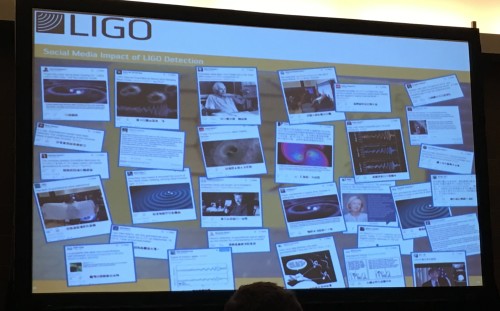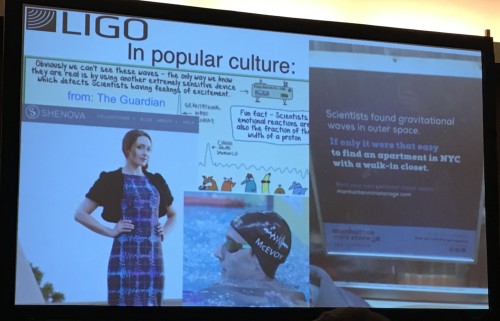
Tweeting to millions: LIGO made a social-media plan before announcing the detection. (Courtesy: Sarah Tesh)
By Sarah Tesh
Nowadays, social media plays a big role in communicating science to the public. It has two important qualities – it’s free and it’s international. A great case study for social media and science came last year when the Laser Interferometer Gravitational-Wave Observatory (LIGO) announced the first ever detection of gravitational waves. To tell us more about how the team grabbed the public’s attention (and got its work on Sheldon Cooper’s T-shirt in The Big Bang Theory), LIGO scientist Amber Stuver gave a witty talk at the APS March Meeting 2017 about the outreach strategy.
She began by telling us the story of that exciting detection day. Before the first detection, LIGO had published 80 papers on “detecting nothing”. Yet on 14 September 2015 – the first morning of the first day of Advanced LIGO – the much-sought-after signal appeared. The first thing that had to be done was to check it wasn’t a fake. Having detected nothing for so long, those with the knowledge to do so would sometimes “inject” results to check the system worked and keep the scientists on their toes.
But word came – “This is not a drill. This is not a fake.” That didn’t mean they could just announce it, however – data and scientists had to be vetted. Stuver explains (to the amusement of the room) that they were “concerned the old timers had gone a little coo-coo” and decided to fake the findings out of sheer desperation. So the scientists had to be “interrogated” before preparing the publication paper. Interestingly, they also organized and planned the outreach and education materials for the announcement. This included a press release, social-media plan, images, videos, a brief history, an educators’ guide for middle and high schools, a science summary for the general public, and an e-mail address specifically for the public’s questions.

961 front pages: the first ever detection of gravitational waves made headlines all over the world. (Courtesy: Sarah Tesh)
Finally, even after leaks and rumours, the paper was published and the finding officially announced on 11 February 2016. And the result of all that extensive outreach planning? The groundbreaking news made it onto 961 newspaper front pages worldwide, LIGO’s Twitter and Facebook accounts gained 19.2K and 8.7K followers respectively, the relevant hashtags got 70 million aggregate impressions, the then President of the United States Barack Obama Tweeted his congratulations, Brian Greene talked about the news on The Late Show, Olympic swimmer Cameron McEvoy had the signal on his cap, fashion designer Holly Rennee made a dress covered in the signal for Shenova, and Sheldon Cooper on The Big Bang Theory wore a LIGO-inspired T-shirt.

Making waves: swimming caps, dresses and comics. (Courtesy: Sarah Tesh)
While the detection of gravitational waves was a huge event in the world of physics, who’s to say that it would have reached the general public’s awareness to such an extent without LIGO’s outreach campaign? The effectiveness of the strategy really demonstrates the benefits of engaging with the public. Nowadays, LIGO continues its outreach (as well as the phenomenal science) with its user-friendly website, educational resources and interactive science exhibit. It will be interesting to see how many future scientists became interested in physics because of LIGO.
Guidelines
Show/hide formatting guidelines
this text was deletedwhere people live in harmony with nature and animals</q>
Some text